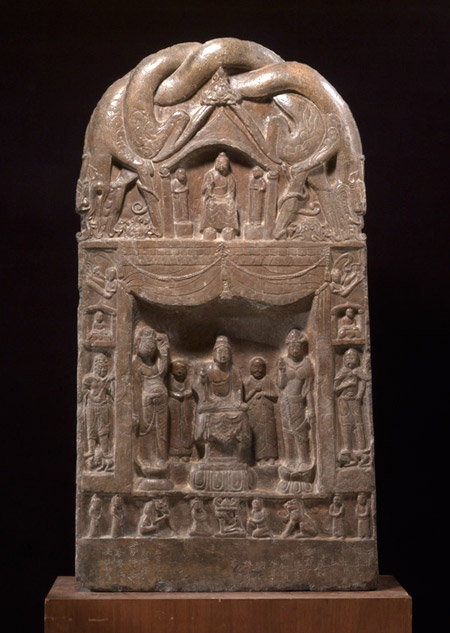Treasures Rediscovered: Chinese Stone Sculpture from the Sackler Collections at Columbia University
March 26–June 21, 2008
 Votive Stele, Tang dynasty (618-906), Limestone
Votive Stele, Tang dynasty (618-906), LimestoneTreasures Rediscovered: Chinese Stone Sculpture from the Sackler Collections at Columbia University introduces a group of twenty-two little-known stone devotional objects and architectural fragments that collectively represent major developments in Chinese religion and mortuary culture, from the Han (206 BCE–220 CE) through the Tang dynasty (618–907). The major emphasis of the exhibition is on works from the sixth century, a period of great intellectual ferment and artistic transformation, above all in the Buddhist arts of China. It will be on view at Columbia University's Miriam and Ira D. Wallach Art Gallery from March 26 through June 7, 2008. Subsequently, the exhibition will travel to the John and Mabel Ringling Museum of Art in Sarasota, the University of Michigan Museum of Art, and the University of Virginia Art Museum.
The objects in Treasures Rediscovered represent highlights of the Chinese stone sculptures that form part of the collections of East Asian and other non-Western art at Columbia University established by Arthur M. Sackler, M.D. (1913–1987). Recent research on the collection has uncovered significant and exciting contextual information on a number of pieces. Objects long separated from their original settings have now been ascribed to specific periods or sites of origin in China on the basis of iconography, style, medium, and other criteria. The exhibition will highlight these groundbreaking discoveries.
The art works range from a small personal votive icon to large temple carvings. Some of the works derive from underground burials where they formed part of an auspicious environment intended for enjoyment by the dead. The majority, however, are Buddhist icons in various formats: objects of devotion that were installed in temples and cave chapels. The Buddhist pieces highlight changes in both style and iconography, indicative of changes in devotional practice and belief; they also reflect regional diversity and heterodox imagery. Taken together, they both enrich and complicate our understanding of early Buddhist art.
Leopold Swergold and Eileen Hsiang-ling Hsu are the co-curators of the exhibition. Mr. Swergold is a graduate of Columbia College (1962), and the Harvard Business School (1964). Since retiring from a career in Wall Street, he has been engaged in a comprehensive independent study of the Sackler Collections at Columbia under the guidance of Professor Robert E. Harrist Jr., the chairman of the Department of Art History and Archeology and a specialist in Chinese Art. A collector of Chinese art for more than twenty years, Mr. Swergold is a trustee of the Freer and Sackler Galleries at the Smithsonian Institution. Eileen Hsiang-ling Hsu received an M.A. in Japanese art history and a Ph.D. in Chinese art history, both from Columbia University. Specializing in Buddhist art, she is an independent scholar and a contractual researcher at the Princeton University Art Museum. She has also written and translated works on Chinese calligraphy, Han pictorial stone carving, and Chinese painting. Her current research focuses on the dichotomy of Buddhist art in the Northern Qi period.
In conjunction with the exhibition the gallery is publishing an extensive exhibition catalogue with essays by Stanley K. Abe of Duke University, Wendi Leigh Adamek of Barnard College, and Dorothy C. Wong of the University of Virginia. The objects, examined in catalogue entries by Chang Quing, Eileen Hsiang-ling Hsu, Annette L. Juliano, Cary Y. Liu, Elinor Pearlstein, and Diana P. Rowan, are lavishly illustrated with photographs by Maggie Nimkin. The 116-page book includes more than 120 illustrations and will be available for $45.
Two lectures are being presented in conjunction with the exhibition. On Thursday, April 17, Sonya Lee, who is on the art history faculty at the University of Southern California, will speak on the topic "Seeing the Buddha's Nirvana on Chinese Steles." On Thursday, May 1, Annette L. Juliano of the art history department at Rutgers, The State University of New Jersey, will present a lecture entitled "Sleeping on Stone: Mortuary Beds in Sixth-Century China." Both lectures, free and open to the public, will take place at 6:15 p.m. in 930 Schermerhorn Hall. Eileen Hsiang-ling Hsu, will lead an exhibition tour on Thursday, April 24 at 6:15 p.m. in the gallery.
The Sackler Collections at Columbia University encompass nearly three thousand objects and are a major resource for teaching and research. In addition to approximately five hundred works from China, the collections include two hundred fifty objects from Korea, and nearly two thousand from the ancient Near Eastern and other cultures, ranging in date from the Neolithic period to the early twentieth century. Among them are ceramics and objects in bronze, stone, and other materials. Available to students at any stage of their academic careers, from undergraduates to advanced Ph.D. candidates, these works serve the university's larger mission of providing instruction in all aspects of the art and culture of China.
Special exhibition website: Treasures Rediscovered ![]()
Major support for the exhibition and the accompanying catalogue comes from the AMS Foundation for the Arts, Sciences, and Humanities, the Miriam and Ira D. Wallach Foundation, and an anonymous donor. Welcome contributions were also received from Giuseppe Eskenazi, London; Dorothy Tapper Goldman; James J. Lally; Dr. David and Mrs. Elvi Menke; and Howard and Mary Ann Rogers. Funding for the project also comes from an endowment established by Miriam and Ira D. Wallach.


